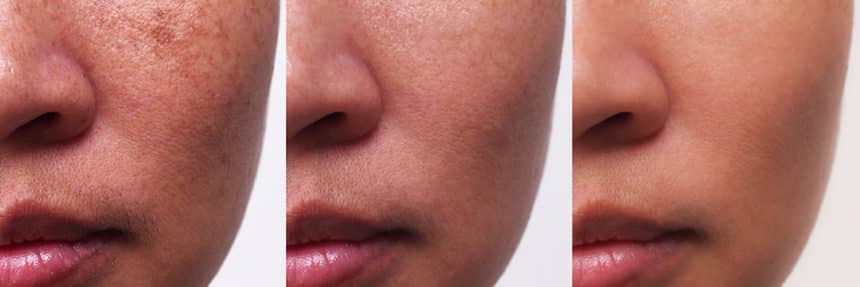
(Shalu, B 2019)
What is Hyperpigmentation?
Most commonly known as age or sunspots, the term hyperpigmentation pertains to dark patches of natural pigment in the skin (melanin), which accumulate in the very outer layer of the skin (epidermis).
While the cause of hyperpigmentation varies, the collection of small molecules at the heart of it is melanin. Melanin is the substance that creates colour or pigment in our skin, hair and eyes. The purpose of the melanin differs according to where it is found in the body. There is even neuromelanin found in our brain, which have distinct pigment and functions (Yousaf, Dervenoulas & Politis 2018)! In the skin however, it acts as our natural UV defence mechanism.
The skin is comprised of several layers. The two outer layers are the dermis and the epidermis. The dermis is where the melanocyte cell lives and the epidermis consists mostly of cells called Keratinocytes (flattened, dying cells). Melanin is produced through a series of chemical reactions in the melanocyte cell, beginning with the oxidation of the amino acid tyrosine involving an enzyme which is aptly named tyrosinase. The resulting melanin is then distributed from the melanocyte to the surrounding Keratinocyte cells(see figure. 1). These very under-rated epidermal cells then divide and are pushed up to the surface where the melanin does its protective magic!
This process happens without external stimulus and the amount and type of melanin varies depending on genetics.

Figure 1. Image of dermis and epidermis, indicating positioning of melanocyte cell and keratonite cells (Caryl, J 2010).
The UV Effect
There are a range of causes of hyperpigmentation from hormonal to scarring. Whatever the cause, UV radiation inevitably makes the condition worse. We all need a good dose of vitamin D. Although a bask in the sunlight is a treat, too much UV exposure is well known to cause a multitude of adverse effects.
So how does this relate to melanin…?
Melanin is our skins natural defence against UV radiation. It protects our DNA from incurring any damage through a range of photoprotective properties. One of the mechanisms through which our melanin does this, is to absorb UV rays and transfer them to heat, causing erythema (redness and inflammation) (Brenner & Hearing 2008). This is why when spending longer periods of time in the sun, it is easy to get burnt. Especially for lighter skin types. The erythema encourages more melanin production to keep up with the increasing demand (Brenner & Hearing 2008). A build-up of erythema causes damage to the melanocyte cell, damaging our DNA in the process. The damage to the melanocyte cell is what makes the pigment accumulate in patches in the epidermis, and that’s when we see hyperpigmentation. Damage to the DNA is what causes premature aging.
Vit C and Tyrosinase Inhibitors
Now back to our friend, tyrosinase.
Since tyrosinase is what begins process of forming melanin, it plays a big part in the treatment of hyperpigmentation. In order to prevent pigmentation from accumulating in patches in the epidermis, we need to supress the production of pigmentation to a degree. This is where the wonder that a tyrosinase inhibitor comes in!
The name is pretty self-explanatory, a tyrosinase inhibitor literally inhibits the enzyme tyrosinase from converting tyrosine to melanin… thus, less pigmentation. There is a plethora of sources of tyrosinase inhibitors. One that has proven most effective is hydroquinone, found in Shiitake mushrooms, which is the star ingredient in DermaQuest’s SkinBrite range. Along with the 8 other tyrosinase inhibitors in these products, hydroquinone helps to even out the skins complexion and get that hyperpigmentation under control!
Another ingredient helping fight this battle is Vitamin C. The benefits of Vit C are extensive. Not only is it vital in the support of healthy collagen formation, it also has powerful lightening properties which contribute to lifting that stubborn collection of pigment in the skin. Last but by no means least, Vit C is a potent antioxidant and fights against free radical damage from UV radiation, ultimately protecting against DNA damage and premature aging.
A combination of Vitamin C and tyrosinase inhibitors are a powerhouse against hyperpigmentation! Add in to your routine, a good physical SPF and hyperpigmentation won’t stand a chance!
References
Brenner, M & Hearing, VJ 2008, ‘The protective role of melanin against UV damage in human skin’, Photochemistry and photobiology, Vol. 84(3), pp.539-549.
Caryl, J 2010, Your microbiome and you (Part II): Skin, Mental Indigestion, viewed 28 February 2020, https://mentalindigestion.net/2010/01/15/your-microbiome-and-you-part-ii-skin/
Shalu, B 2019, Hyperpigmentation Guide: Treatments, Types, Causes and Preventions, Fabbon, viewed 28 February 2020, https://fabbon.com/articles/makeup/hyperpigmentation-treatment-types-causes-and-prevention
Yousaf, T, Dervenoulas, G & Politis, M 2018, ‘Advances in MRI Methodology’, International review of neurobiology, Vol. 141, pp. 31-76, Academic Press.

Leave a Reply